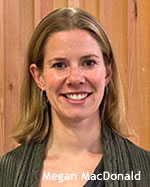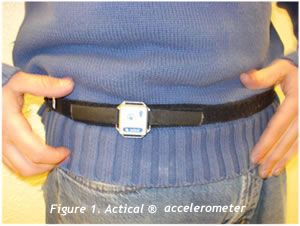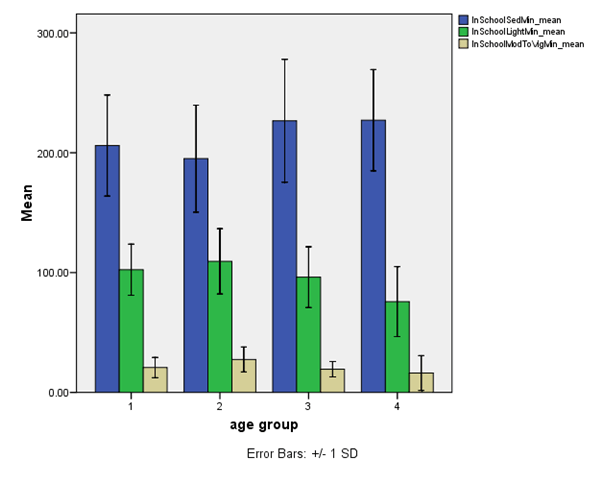THE PHYSICAL ACTIVITY PATTERNS OF CHILDREN WITH DOWN SYNDROME DURING SCHOOL
written by Megan
MacDonald1 (corresponding author), Phil Esposito2, Dale
Ulrich2
 Background Background
The obesity epidemic facing the nation is well-known. In fact,
recent reports from the Whitehouse have clearly established
health & well-being as a national priority (USDHHS, 2000).
Health, as we know it, includes many aspects one of which
is physical activity.
The physical activity patterns of children and youth with
Down syndrome (DS) are not well known. DS is the most common
genetic cause of intellectual disability, and occurs in approximately
1 in every 700 live births (CDC, 2011). Individuals with DS
are at a higher risk for obesity, osteoporosis, musculoskeletal
disorders and cardiovascular related health problems, all
risk factors that can be improved with moderate bouts of physical
activity (Barnhart & Connolly, 2007).
A significant portion of a child's day takes place in school,
and physical activity occurs in different amounts throughout
the school day both formally and informally. Better understanding
how much physical activity occurs during school can help us,
as physical educators, towards creating effective programs
to increase in-school physical activity at different ages.
The purpose of this study is to understand the physical activity
patterns of children and youth with DS during the school day
across four different age groups.
Method
Children 8-18 years of age, with DS, were recruited through
parent support groups in the state of Michigan (n= 71). Each
child wore an Actical ® accelerometer for a period of
seven days (see figure 1). The accelerometers recorded physical
activity counts in 15 second intervals. Accelerometer data
were cleaned based on the following criteria: 1) the monitor
was worn for 10 hours per day 2) the monitor was worn for
a minimum of four days and 3) one of the four days was a weekend.
 Regular
school days and regular school hours were selected from the
physical activity count data and analyzed. Physical activity
was grouped into the categories of sedentary, light and moderate,
to vigorous based on the previously established and validated
physical activity counts from accelerometer data (Payau, Adolph,
Vohra, Zakeri, & Butte, 2004). Regular
school days and regular school hours were selected from the
physical activity count data and analyzed. Physical activity
was grouped into the categories of sedentary, light and moderate,
to vigorous based on the previously established and validated
physical activity counts from accelerometer data (Payau, Adolph,
Vohra, Zakeri, & Butte, 2004).
Sedentary activity was coded if physical activity counts
were less than 25, light activity was coded if physical activity
counts were between 25-375, and moderate to vigorous physical
activity was coded if physical activity count was above 375
(all counts were based on 15 second intervals).
Four age groups were created: 8 and 9 years (n= 19), 10 and
11 years (n= 25), 12 and 13 years (n= 16) and 14 and 15 years
(n= 11). A mixed-model analysis was performed across age groups
and covered for the amount of time spent wearing the physical
activity monitor while in school. Post-hoc bonferroni corrections
were performed across each age group comparison.
Results
Significant differences existed across age groups in time
spent in sedentary (p < 0.001), light (p < 0.001) and
moderate to vigorous physical activity (p < 0.01). Post-hoc
pairwise comparisons indicated that students with DS in the
14 and 15 year age group were spending more time in sedentary
activity compared to the 8 and 9 year age group, and 10 and
11 year age group (p < 0.05).
Youth in the 14 and 15 year age group were also obtaining
significantly less light activity than students falling in
the 8 and 9 year and 10 and 11 year age group (p < 0.05),
and obtaining significantly less moderate to vigorous physical
activity compared to the 10 and 11 year old age group (p <
0.05).

In short, these results suggest that children are participating
in more sedentary physical activity, and less moderate to
vigorous physical activity as they age. The results suggest
that daily averages are significantly different and less physically
active than younger children who also have DS.
Conclusions
It appears that physical activity obtained in school decreases
as children with DS get older. Youth who fall into the oldest
age group of 14 and 15 years seem to be the most at risk for
physical inactivity during school. In general sedentary behavior
increases as light and moderate to vigorous physical activity
decrease.
These results corroborate previous studies that have found
lower levels of physical activity in adolescents when compared
to younger children (Esposito, MacDonald, & Ulrich, in
press; Troiano, 2007). Interventions focused on physical activity
have the potential to act as a preventative measure in health
related problems associated with DS. This study strongly supports
the implementation of quality daily physical activity during
school for all children and youth, especially those with DS.
1 School of Biological & Population Health Sciences,
Exercise & Sport Science Program, Oregon State University,
Corvallis, OR
2 Center on Physical Activity & Health in
Pediatric Disabilities, School of Kinesiology, University
of Michigan, Ann Arbor, MI
Megan MacDonald is an Assistant
Professor of Movement Studies in Disability at Oregon
State University. She received a PhD in Kinesiology from the
University of Michigan in 2011.
(back
to pelinks4u homepage) |




 Background
Background Regular
school days and regular school hours were selected from the
physical activity count data and analyzed. Physical activity
was grouped into the categories of sedentary, light and moderate,
to vigorous based on the previously established and validated
physical activity counts from accelerometer data (Payau, Adolph,
Vohra, Zakeri, & Butte, 2004).
Regular
school days and regular school hours were selected from the
physical activity count data and analyzed. Physical activity
was grouped into the categories of sedentary, light and moderate,
to vigorous based on the previously established and validated
physical activity counts from accelerometer data (Payau, Adolph,
Vohra, Zakeri, & Butte, 2004). 